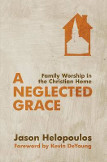
The Power of a Preface: Packer on Owen
“Here comes the bookman,” he said in his familiar southern drawl. It was early evening, and the porch swing seemed to be exactly the place where we belonged. We could see the long driveway from our vantage point, and sure enough, here came the bookman!
That’s always good news.
The bookman? The UPS guy, of course!
When he came, there were always boxes from Banner of Truth, CBD, Cumberland Valley Bible Books, etc. So, when my dear Dad looked from the porch of our house on Tater Peeler Road in Lebanon, TN (yes, that’s the name of the road – you can look it up) and saw the UPS guy barreling up the driveway, he looked at me and said with a knowing grin, “Here comes the bookman.”
Things were different then. These were the early 90’s. If you wanted one of those big, fat sets of Puritan reprints, you had to walk to your mailbox, get the catalog from book distributors, fill out an order form by hand, mail off a check, and wait.
And, wait.
And… you get the picture.
This was an especially memorable bibliophilic day. I opened the box to find the green and white dust jackets that protected those precious pearls, known as The Works of John Owen. This was not my first foray into Owen. Like many of you, I had the stand-alone Banner edition of The Death of Death in the Death of Christ; and, as wonderful as the whole set is, when I had that old paperback of The Death of Death in my hand I had two treasures in one.
First appearing in the Banner of Truth's 1958 reprint of Owen's classic work, J.I. Packer’s preface emerged as an intro that drew the reader in--not only to Owen’s work, but to what has to be one of the most logical and lucid guides to Reformed soteriology. When one reads Packer on Owen and then reads Owen there is an irresistible desire to want more. So great is this preface that it went on to be published as stand-alone booklet--something that has not often happened in the history of theological publishing.[1]
Packer structures his intro in five unnamed sections:
1) Packer pulls no punches!
“The Death of Death in the Death of Christ (Owen, Works, X:139-148) is a polemical piece, designed to show, among other things that the doctrine of universal redemption is unscriptural and destructive of the gospel.” Packer was confident in beginning because there was an “upsurge of interest in the theology of the Bible.” These were the new halcyon days of resurgent interest in Reformed and Puritan thought. The combined labors of men, like Packer and Lloyd-Jones, blazed theological trails down which new Puritan pilgrims progressed for the next several years.
The (then) new gospel of Packer’s day seemed to focus on man’s happiness, rather than God’s holiness. Packer explains:
Thus, we appeal to men as if they all had the ability to receive Christ at any time; we speak of his redeeming work as if he had done no more by dying than make it possible for to save ourselves by believing; we speak of God’s love as if it were no more than a general willingness to receive any who will turn and trust; and we depict the Father and the Son, not as sovereignly active in drawing sinner to themselves, but as waiting in quiet impotence ‘at the door of our hearts’ for us to let them in…The Bible is against us when we preach in this way; and the fact that such preaching has become almost standard practice among us only shows how urgent it is that we review this matter.
2) Packer gets feisty about the Five Points!
Progressing on, Packer anticipates the charge that Calvinists only care about the five points, because the five points of Calvinism are all there is to Calvinism. He refutes this historically by giving us a 30,000ft. fly-over of Dort, where its 1618 Synod gave five Calvinistic points of response to five Arminian points of remonstrance. Yet, he finds himself something of a frustrated five-pointer. You see, Calvinism is much more than a mere five points. It is a “whole world-view,” a “unified philosophy of history.” As important as the five points are, as five points, they are innately polemical and negative in their formulation. Again, there was a historical context to their production. Calvinistic soteriology, says Packer, is actually inherently, “expository, pastoral, and constructive.” It is the Arminian position that is innately negative in its own five-point denial of positive biblical assertions about God’s economy of salvation. Calvinism “negates these negations” via the five points, five organic, hanging-together points, in order to protect the organically singular teaching of Scripture that God positively sovereignly saves sinners. Yet, simply negating negations does not do justice to the significant differences between Arminian and Calvinistic views of man’s relation to election, redemption, and grace. Negating negations may lead one to assume that Calvinism is a mere reactionary modification of Arminianism, when, in reality, the former, far from being the product of “unhallowed logic,” is really the most natural, inescapable reading of the text of Scripture.
3) Packer Insists that a Limited Atonement is a Lavish Atonement!
Picking up on his insistence that Calvinism is positive, constructive, Packer insists we not misconstrue Owen’s limiting of the atonement. Indeed, he is doing something quite constructive by explicating just how deep and full and lavishly rich the biblical teaching on the atonement actually is. The extent of the atonement is first a question of its nature. Bks I-II – Christ’s death actually saves his people; Bk III – sixteen arguments confounding universal atonement; Bk IV – correct exegesis of the “world” and “all” passages of Scripture, rescuing them from the distortions of Arminian eisegesis.
Does Owen succeed exegetically? Packer was unequivocal when he wrote:
One searches his book in vain for the leaps and flights of logic by which Reformed theologians are supposed to establish their positions; all that one finds is solid, painstaking exegesis and a careful following through of biblical ways of thinking. Owen's work is a constructive, broad-based biblical analysis of the heart of the gospel, and must be taken seriously as such. It may not be written off as a piece of special pleading for a traditional shibboleth, for nobody has a right to dismiss the doctrine of the limitedness, or particularity, of atonement as a monstrosity of Calvinistic logic until he has refuted Owen's proof that it is part of the uniform biblical presentation of redemption, clearly taught in plain text after plain text. And nobody has done that yet.
4) Packer Suggests that Owen’s Book Can Help Free Us!
When Packer says that Owen's work can help set us free we have to ask, "set us free from what?" The answer is simple, "From the following kind of preaching:"
What we say comes to this - that Christ saves us with our help; and what that means, when one thinks it out, is this - that we save ourselves with Christ's help. This is a hollow anticlimax. But if we start by affirming that God has a saving love for all, and Christ died a saving death for all, and yet balk at becoming universalists, there is nothing else that we can say. And let us be clear on what we have done when we have put the matter in this fashion. We have not exalted grace and the cross; we have limited the atonement far more drastically than Calvinism does, for whereas Calvinism asserts that Christ's death, as such, saves all whom it was meant to save, we have denied that Christ's death, as such, is sufficient to save any of them. We have flattered impenitent sinners by assuring them that it is in their power to repent and believe, though God cannot make them do it. Perhaps we have also trivialized faith to make this assurance plausible ('it's very simple - just open your heart to the Lord . . .'). Certainly, we have effectively denied God's sovereignty, and undermined the basic conviction of true religion - that man is always in God's hands. In truth, we have lost a great deal. And it is, perhaps, no wonder that our preaching begets so little reverence and humility, and our professed converts are so self-confident and so deficient in self-knowledge and in the good works which Scripture regards as the fruit of true repentance.
5) Packer Insists that Hard Study is Required.
Packer has welcomed us to read Owen. Now, he warns us. As Owen, himself, said, The Death of Death in the Death of Christ is not for title gazers. You’ll need to put on your thinking cap or your crash helmet, because you’ll either think or crash when it comes to reading Owen’s “masterpiece.” To effectively dismantle the three main shades of universal redemption, as found in classical Arminianism, Amyraldianism, and Thomas More is no light task. Packer cautions us, “Owen is heavy and hard to read,” has a “lumbering literary gait,” reads like, “ roughly-dashed-off translation of a piece of thinking done in Ciceronian Latin,” and has, “a certain clumsy dignity,” just like, “Stonehenge[!]” Packer admits to having to read certain sections aloud, in effort to concentrate properly, and highly recommends the reader proceed with paper and pencil in hand (just add a pipe in your teeth, and you will do C.S. Lewis proud).
So, read this preface. May I be so forward as to suggest to you that you read it once a year, just to hit theological “reset.” If you can’t find it in booklet form, the text is available online in a number of places. Maybe, you could read it in the flow of Packer’s chapters in A Quest for Godliness.
Whatever avenue you take, after you read it, contact the bookman and have him drop off a big box of John Owen at your house.
[1] Not only was this preface published as a booklet, it is also a chapter (Ch. 8, to be exact), entitled, Saved by His Precious Blood, in Packer’s wonderful, A Quest for Godliness: The Puritan Vision of the Christian Life. One also thinks of C.S. Lewis’s A Preface to Paradise Lost, which was published as a substantial book.



















 © Alliance of Confessing Evangelicals
© Alliance of Confessing Evangelicals


